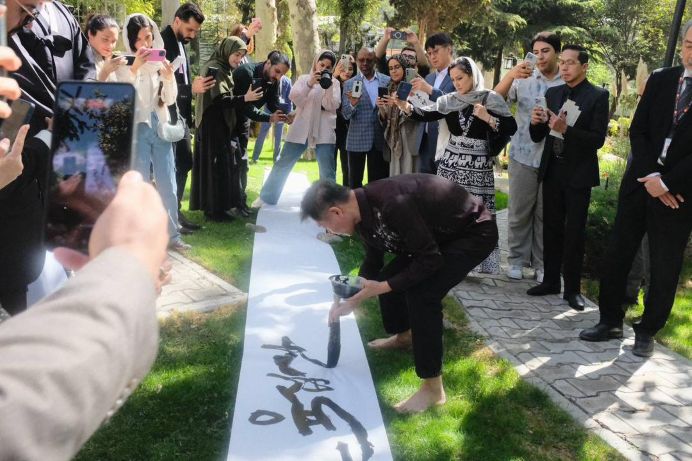
By Alireza Bahrami
TEHRAN: In the 63rd year of diplomatic relations between Iran and South Korea, art once again played a role of a bridge between the two nations. The South Korean Embassy in Tehran, in cooperation with the Cultural Coordination Center of the Asian Cooperation Dialogue Forum (CCCACD), hosted a joint Iran-Korea calligraphy exhibition titled “Family”; an event that was attended by the Korean Ambassador, his wife, the Vice President and President of the Korean Calligraphers Association, prominent Iranian artists, and a group of cultural figures.
Opening Ceremony; Speech by the South Korean Ambassador
At the beginning of the program, Kim Jun-pyo, the Ambassador of the Republic of South Korea to Iran, while welcoming the guests, considered this day a symbol of the enduring friendship between the two nations and said:
“In the 63rd year of diplomatic relations between Iran and Korea, calligraphy has become our common language; a language that speaks of beauty and mutual respect.”
He thanked Dr. Mohammad Jafari Malek, the head of the CCCACD Center, for his cooperation in organizing this event and added:
“This exhibition is not only an opportunity to showcase art, but also a bridge between hearts. Iranian and Korean calligraphy, although different in appearance, are close in spirit and meaning.”
Kim Jun-pyo also mentioned the presence of twelve Korean artists led by Yoo Hyun-duk (chairman of the Korean Calligraphers Association) and Choi Jong-moon (vice chairman of the association) and three Iranian artists including Tandis Taghavi, Israfil Shirchi, and Mojtaba Sabzeh, and said that this exhibition is “a new beginning for the artistic exchange between the two countries after nine years.”
A performance from the heart and meaning
Following the ceremony, Choi Jong-moon, the vice chairman of the South Korean Calligraphers Association, performed a live art performance, writing a text on canvas on the occasion of “Sixty-three years of Iran and Korea being together”; The performance was well-received by the audience and, according to some of the artists present, “expressed spiritual unity in the silence of calligraphy.”
Iranian Artists’ Presence; From Meaning to Technique
Three well-known artists with different approaches but sharing the theme of “family” participated in the Iranian section of the event.
Tandis Taghavi, the president of the Iranian Calligraphers’ Association in Manila, was present with a Quranic work about the bond between women and family in Islamic culture and said in his speech:
“Calligraphy for me is the language of dialogue between cultures; where words can be understood without translation.”
Israfil Shirchi, one of the prominent masters of Iranian calligraphy and calligraphy, said in his speech to the ambassador and Korean artists that “the beauty of Persian calligraphy is a bridge between reason and emotion,” adding:
“When cultures sit side by side with respect, art finds meaning; just as today in this house, Iran and Korea are seen in the same frame.”
Mojtaba Sabzeh also addressed the subject of family from a more contemporary perspective, describing his work as a combination of calligraphy and images; an experience that, according to him, is “an effort to convey Iranian tradition in today’s language.”
Attendees at the ceremony noted the diversity of Iranian artists’ approaches and considered the integration of Eastern feelings in their works to be the distinguishing point of this exhibition.
Korean narratives of the concept of family
In the Korean section, works by twelve members of the South Korean Calligraphers Association were displayed.
Hyun Tak Yoo, the association’s president, described family as a refuge of love and affection in a work titled “What is Family?” and said:
“Family is the place to which a person returns in any situation; even when words lose their meaning, family love is still alive.”
Min Young Park, a poet and vice president of the association, narrated the concept of family over time in a work titled “Love and Memory”: from a mother who is no longer around to a love that remains in the memory of generations.
Other works in the collection, including Choi Jae-gun’s “Forgiveness” and Shim Yun-ok’s “Harmony and Respect,” also had a wide resonance among Iranian audiences with their philosophical view of the relationship between family members.
From Cultural Exchange to the Economy of Art
On the sidelines of the ceremony, Ayeh Bahmani, the daughter of the famous Iranian poet Mohammad Ali Bahmani and the director of international affairs at the Station Cultural Complex, considered holding cultural and artistic events at the international level and presenting Iran’s exquisite contemporary art to the world as one of the company’s goals, and expressed her hope that these events would be held more often than before.
Beyond the Line; A Bond of Humanity
The joint calligraphy exhibition between Iran and Korea was not only a tribute to the 63 years of diplomatic relations between the two countries, but also a reminder of the fact that “line” can go beyond language and become a dialogue between humans.
At the end of the ceremony, the South Korean ambassador, referring to the welcome given to Iranian and Korean artists, said:
“I hope these cultural dialogues will continue; Because every time pen is put to paper, our friendship deepens.”




